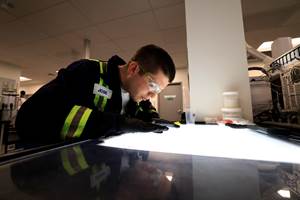'Father of Long Glass' Delivers a New Baby
Ron Hawley's lawyer keeps a collection of napkins and other bits of paper on which, over the years, Hawley drew the first sketches of a remarkable series of inventions.
Ron Hawley's lawyer keeps a collection of napkins and other bits of paper on which, over the years, Hawley drew the first sketches of a remarkable series of inventions. Known as the "father of long glass," Hawley helped pioneer the development of pultruded long-fiber thermoplastic (LFT) pellets. That project became his first entrepreneurial venture, which was sold to Hoechst Celanese (now Ticona) in the 1980s. Hawley, who was only 42 at the time of the sale, thought he would retire.
After a year on the sidelines, Hawley helped a friend, Don Harbst, with a molding trial of some long-glass pellets. They didn't feed well. "I spent an afternoon poking the half-inch pellets into a hopper with a broomstick, and I figured there had to be a better way," Hawley recalls. The better way became his next big invention, an in-line LFT compounding and molding process. Nowadays, this approach is referred to as "direct" LFT or D-LFT. Hawley and Harbst set up Composite Products Inc. (CPI) in Winona, Minn., in 1989 to mold D-LFT parts and license the process.
CPI's D-LFT process was limited to compression and transfer molding. But applications were appearing elsewhere for LFT injection molding, especially in automotive. Hawley, who is chairman, president, and CEO of CPI, knew that the company would have to adapt D-LFT to injection molding. He tried filling injection molds with shots from CPI's long-glass extrusion compounders, but their output was so large that it overwhelmed the injection press and could only be used to make enormous parts.
"I wanted to develop a D-LFT injection process that was small, compact, and retrofittable to any injection press in the field," Hawley says. He also wanted it to be flexible enough to allow the press to switch back and forth between D-LFT and conventional molding. That became the premise for Hawley's third and latest venture, Woodshed Technologies.
Push, don't pull
Established four years ago, Woodshed developed the world's first retrofittable D-LFT process for conventional injection machines. "We designed it for presses in the 200- to 500-ton range to mold parts from a few ounces up to 3 to 4 lb," Hawley says. The apparatus starts with a small secondary injection unit that melts the polymer and feeds it into a long tubular "entrainment die." There the melt wets out glass roving pulled off a creel. Pressure in the entrainment die is 8000 to 15,000 psi. Melt and roving are chopped by a cutting device at the far end of the tube.
Hawley calls this method "pushtrusion." It differs from pultrusion in that fibers are pushed through the tube by the flow of resin, not pulled by an apparatus in front of the die.
In Woodshed's process, molten glass-filled resin is side-fed into the main injection barrel at low pressures of about 100 psi. The screw conveys the melt gently at low shear. Some fiber breakage occurs as the compound goes through the injection barrel, Hawley says, but far less than when long-glass pellets are remelted in an extruder.
Woodshed aims to license its technology rather than mold parts. "We want to be able to offer training, application expertise, and materials development," Hawley says. Woodshed has an OEM partner that will assemble and install the equipment system. Woodshed will supply the OEM with certain proprietary components like the fiber creel, entrainment die, and fiber-cutting device. Hawley also seeks to form relationships with material suppliers to support applications development.
Woodshed's developmental system feeds a 230-ton press and can mold up to a 1-lb shot in a 1-min cycle. It has been tested with 20%, 30%, and 40% long-glass PP and nylon 6. Hawley has no doubt that the technology will work with other engineering resins like TP polyesters and urethanes. The process can also produce short and medium-length fiber material.
CPI is Woodshed's first licensee and beta-test site and is working on the first commercial part for a marine application, which is expected to go into production this fall. Hawley says he is already in serious discussions with a half dozen other molders interested in licensing Woodshed technology.
Related Content
New Entrant Heartland Polymers Stepping up as Reliable Supplier
Heartland Polymers’ new Alberta, Canada facility will produce 525 KTA propylene and 525 KTA polypropylene. It is expected to stabilize supply chains across the continent.
Read MoreThe Effects of Time on Polymers
Last month we briefly discussed the influence of temperature on the mechanical properties of polymers and reviewed some of the structural considerations that govern these effects.
Read MorePrices of All Five Commodity Resins Drop
Factors include slowed demand, more than ample supplier inventories, and lower feedstock costs.
Read MoreThe Strain Rate Effect
The rate of loading for a plastic material is a key component of how we perceive its performance.
Read MoreRead Next
Lead the Conversation, Change the Conversation
Coverage of single-use plastics can be both misleading and demoralizing. Here are 10 tips for changing the perception of the plastics industry at your company and in your community.
Read MoreWhy (and What) You Need to Dry
Other than polyolefins, almost every other polymer exhibits some level of polarity and therefore can absorb a certain amount of moisture from the atmosphere. Here’s a look at some of these materials, and what needs to be done to dry them.
Read MorePeople 4.0 – How to Get Buy-In from Your Staff for Industry 4.0 Systems
Implementing a production monitoring system as the foundation of a ‘smart factory’ is about integrating people with new technology as much as it is about integrating machines and computers. Here are tips from a company that has gone through the process.
Read More

























